实用商务英语综合教程(中级)-配套教案
- 格式:doc
- 大小:207.50 KB
- 文档页数:39
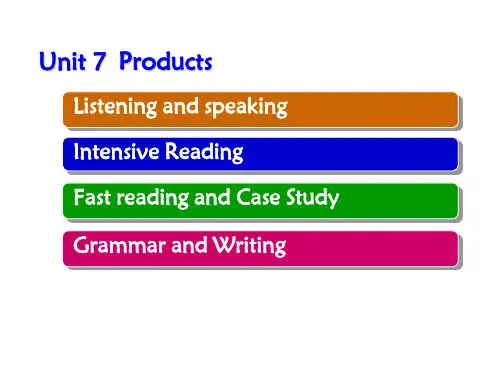
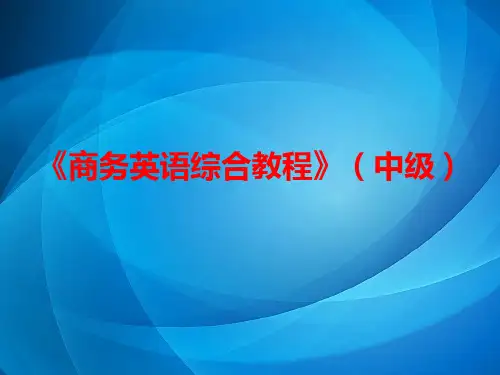
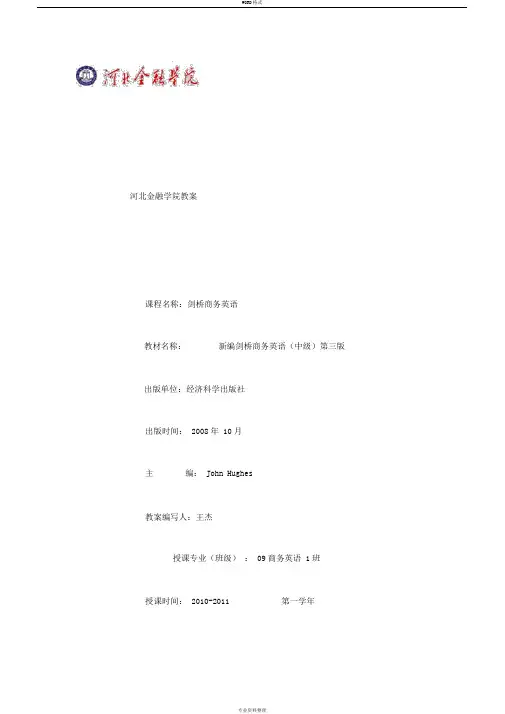
河北金融学院教案课程名称:剑桥商务英语教材名称:新编剑桥商务英语(中级)第三版出版单位:经济科学出版社出版时间: 2008年 10月主编: John Hughes教案编写人:王杰授课专业(班级): 09商务英语 1班授课时间: 2010-2011 第一学年河北金融学院课程教案授课教师:课题教学基本要求与目标方法与手段实践性环节课外要求王杰授课班级: 09 商务英语 1 班授课时间: 2010.9.6Lead-in Introduction to BEC Vantagemake students to get familiar with the BEC Vantageintroduction, explanation with the assistance of PPTdiscussion, ask and answerTo read more books about business, often go on line to practise listening BEC 内容(其中:重点划“△” ,难点划“﹡”)课时分配I. Introduction to BECReading test (60 minutes, 45 questions)△Reading test part one (7 questions)Reading test part two (5 questions)Reading test part three (6 questions)Reading test part four (15 questions)Reading test part five (12 questions)Writing test (45 minutes, 2 parts)△Writing test part one (40-50 words in forms of noteMessage,email or memo)Writing test part two (120-`140 words in forms ofreport Or business letter) Listening test (40 minutes, 3 parts 30 questions)﹡Listening test part one (three conversations)Listening test part two (two sections 10 questions)Listening test part three (one passage 8 questions) Speaking test (14 minutes, 3 parts)△3minutes) Speaking test part one (personal informationSpeaking test part two (mini-presentation 6 minutes)Speaking test part three (collaborative task 5minutes ) II. How to study BEC Vantage1. business words and phrases2. read more business background3. listening more BEC4. accumulative more business topic5. often go on line with good websitesIII. Asking questionsSs may ask any questions concerning BEC. 10m 8m12m20m10m 10m 10m 10m 10mSince this is the first class, students appear a little bit puzzled. But after the introduction with encouraging课后心得information, they start to become more interested to explore BEC.1河北金融学院课程教案授课教师: 王杰 授课班级: 09 商务英语 1 班授课时间: 2010.9.9课 题Module one ways of working教学基本 To enable Ss to talk about ways of working; to enable Ss to get more information from要求与目标 ways of working.方法与手段 Explanation, multimedia, interactive teaching实践性环节 listening speakingreading课外要求Read more material concerning ways of working内容(其中:重点划“△” ,难点划“﹡”)I. different ways of workingRegular time/flexible hours; in a team/ on your own From home/in an office; for a boss/as your own bossII. reading (read about job sharing, write these headings into each paragraph) △Get organized set your limits put pen to paper two become one Open your mind plan for disaster fine the perfect partner don ’tfeel guiltyIII. working from home (listening) ﹡a. What is important when working form home? have a timetable and stick to it.b. advantagesYou spend more time with the children More flexibilityThe company saves money on office space No commutingc. DisadvantagesSometimes you work in the evening; You miss people and office newsd. Complete the notes about Michela’ s typical day 7:00 get up, get the kids ready8:30 take kids to school9:00 start work12:00 have lunch 14:30 finish work2.She has been with current employer since she left school, but she home-working for five years.3.she ’ s going to the office every day to meet visitors.IV . grammar tipComplete these tips for working from home V. a mini-presentation △Job sharing working from home课时分配10m20m40m ’ s been10m 20mThey are lack of English-thinking and active response. Ss are lack of listening skills, so ask students to listen课后心得more business English.2河北金融学院课程教案授课教师:王杰授课班级: 09 商务英语 1 班授课时间:2010.9.16 课题Module one making contacts and speaking test part one教学基本To enable Ss to talk about making contacts; to enable Ss to get moreinformation from要求与目标making contacts; know more about speaking test part one.方法与手段Explanation, multimedia, interactive teaching实践性环节listening speaking reading课外要求Read more material concerning making contacts and often go on line.内容(其中:重点划“△” ,难点划“﹡”)课时分配I. job responsibilitiesI work for ⋯⋯I ’ m involved in ⋯⋯I ’ m responsible for ⋯⋯I deal with ⋯⋯I usually report to ⋯⋯I ’ m in charge of ⋯⋯I specialise in ⋯⋯II.life ’s all about making connections (reading)△1.socialising 社交活动2.attend a conference/ trade fair3.new clients and partners4.share ideas with5.coffee break/ tea break6.a formal networking grouprmal drinks eveningIII. starting a conversation (listening) ﹡a. at a conferenceb. over dinnerc. in someone’s officed. on a training courseIV . business correspondence△a.we should know more about four forms of writings, they are note, message,email and memo.b.We should know more about formal and less formal expressions.V. Speaking test part one﹡The questions are quite general at first:1.About yourself2.About your studies or career3.About where you come fromAfterwards, he or she may ask you questions4. About business topics10m20m30m20m20mAsk Ss to listen more, especially business situation, encourage Ss to speak more and let them know the skills课后心得and rules of BEC Vantage3河北金融学院课程教案授课教师:王杰授课班级: 09 商务英语 1 班授课时间:2010.9.20 课题Module two company benefits教学基本To enable Ss to talk about job; to enable Ss to get more information about company要求与目标benefits方法与手段Explanation, multimedia, interactive teaching实践性环节listening speaking reading课外要求Read more material concerning company benefits and often go on line.内容(其中:重点划“△” ,难点划“﹡”)I.benefits and incentives﹡(speaking and listening)A.an impressive job titleB.training and staff developmentC.a good salaryD.a pensionE.flexible working hoursF.opportunities to travelG.opportunities for promotionH.parental leaveI.d ays off and long holidaysJ.a company carII.Is working for Xerox too good to be true?1.client service executive2.be amazed at 对⋯⋯感到惊奇3.tempting 吸引人的4.a pinch of salt 半信半疑5.take part in6.incumbent在职的7.human resources8.policy of promotingIII.asking questions about jobsWhy do you like the company?How long have you been working in the company?IV . A letter of application﹡Read this advert for a job and use the handwritten notes to write a letter of application (120-140 words )similar to writing test part two.课时分配30m20m10m40mAsk Ss to listen more, especially business situation, encourage Ss to write more and let them know the skills课后心得of writing.4河北金融学院课程教案授课教师:王杰授课班级: 09 商务英语 1 班授课时间:2010.9.25课题Module two presenting your company and reading test part five, writing test教学基本To enable Ss to talk about presenting your company; to improve the skills ofreading and要求与目标writing方法与手段Explanation, multimedia, interactive teaching, writing实践性环节listening speaking reading writing课外要求Know the skills of presenting your company and often go on line.内容(其中:重点划“△” ,难点划“﹡”)课时分配I. company terms20m1. distribution centrePlace where goods are sent out to be sold2. warehousePlace where goods are stored3. holding companyCompany which controls others with the largest stake (over 51%)4. call centre 客户服务中心Place where employees give information to customers by telephoneII. giving a presentationSpeakingKey points: figures structure trendsIII.writing memo1.who is the memo to?2.who will be interested in the information?3.what has happened?4.what is happening as a result?5.what action is needed?IV . reading test part fiveIt is always a short text of about 150-200 words, you have to identify incorrect or extra words in the sentences in the text. 20m 2020mV. writing test part one20m In part one you must write an internal communication such as a note,message, memo or email of around 40-50 words.Ask Ss to listen more, especially business situation, encourage Ss to write more and let them know the skills课后心得of writing.5河北金融学院课程教案授课教师:王杰授课班级: 09 商务英语 1 班授课时间:2010.9.27课题Module three starting a business教学基本To enable Ss to talk about start a business; to improve the skills of reading and listening 要求与目标方法与手段Explanation, multimedia, interactive teaching, listening实践性环节listening speaking reading writing课外要求Know the types of business and often go on line.内容(其中:重点划“△” ,难点划“﹡”)I. types of businessSole trader you take all the profit.If you go bankrupt, you lose everything.Partnership you share the pressure.You might disagree on strategy.Franchise The business model is given to you so there is less risk.Part of your profits goes to the franchisorII.reading1.ludicrous 荒唐可笑的2. branch out 拓展业务3.branch out into 把规模扩大到 ...方面4.enterpreneurial spiritenterpreneurial courage 企业家的胆略 5. sole trader6.short-livedIII. listeningListen to a trainer doing a seminar on being anentrepreneur Planning a seminar课时分配20m20m20mIV . speaking tesstA. What is important when⋯⋯Setting up your own business1.A good idea2.Knowing your customersB. When is important when ⋯⋯?Your business is a partnership1.relationship with the other person2.shared responsibility3. 20m 20mAsk Ss to listen more, especially business situation, encourage Ss to write more and let them know the skills课后心得of writing.6河北金融学院课程教案授课教师:王杰授课班级: 09 商务英语 1 班授课时间:2010.9.30课题Module three leaving and taking messages, listening test part one教学基本To enable Ss how to leave and take messages; to improve the skills ofreading and要求与目标listening方法与手段Explanation, multimedia, interactive teaching, listening 实践性环节listening speaking reading writing课外要求Know the types of business and often go on line.内容(其中:重点划“△” ,难点划“﹡”)I. Leaving messagesA. to ask for permissionB. to complain about a mistakeC. to complain something is OKD. to request informationE. to offer informationF. to cancel arrangementsG. to request helpH. to change a bookingII. writing (taking notes and messages)Eg. I’d be grateful if you could return this call on my home number.Call him back on his home number.III. listening test part oneIt always consists of three listening texts which are telephoneconversations or messages on answering machines.Text include forms, notes, invoices or message pads留(言本 ).You need to listen in particular for information like names, numbers,dates, instructions or deadlines.Exam successBefore listening, study the form or notes you have to complete.Use the information in the notes to try and predict what you are listening for Don’twrite more than one or two words per gap.Don’t panic if you don’t understand everything the first time. You hear it twice.课时分配20m20m20m20m20mAsk Ss to listen more, especially business situation, encourage Ss to write more and let them know the skills课后心得of writing.7河北金融学院课程教案授课教师:王杰授课班级: 09 商务英语 1 班授课时间:2010.10.11课题Module four advertising教学基本To enable Ss know more about advertising on the web and advertisingstandard;要求与目标to improve the skills of reading and listening方法与手段Explanation, multimedia, interactive teaching, listening 实践性环节listening speaking reading writing课外要求Know the types of advertising and often go on line.内容(其中:重点划“△” ,难点划“﹡”)I. Types of advertising1.word of mouth2.mailshot 邮寄广告 commercials4.spam 垃圾电子邮件5.banners /streamer横幅6.newspaper adverts7.brochures8.sampleII. Speaking a short presentation1.The first thing is to ⋯⋯2.It’s a good idea to⋯⋯3.You can do this by⋯⋯4.Also remember that⋯⋯5.My third tip is (never) to ⋯⋯6.Before we finish don’tforget ⋯⋯7.What might be better is to⋯⋯III. reading advertising standardsASA (Advertising Standards Authority)1.keep advertising legal, decent, honest and truthful2.a set of codes3.independently (both government and the advertising industry)Case study oneCase study twoCase study three课时分配20m40m20mIV . grammar Modals20m Underline the modal verb in each sentence and write it in this summaryAsk Ss to listen more, especially business situation, encourage Ss to write more and let them know the skills课后心得of writing.8河北金融学院课程教案授课教师:王杰授课班级: 09 商务英语 1 班授课时间:2010.10.14 课题Module four advertising教学基本To enable Ss know more about delegating;要求与目标to improve the skills of writing方法与手段Explanation, multimedia, interactive teaching, listening实践性环节listening speaking reading writing课外要求Know how to improve business skills of delegating and often go on line.内容(其中:重点划“△” ,难点划“﹡”)课时分配I. reading, delegating1.bits and pieces 零碎东西2.a whole manageable project3.rise to 证明能够应付4.deadline5.update6.lots of praise7.helpful feedback8.constructive criticismII. listening a bad delegatorListen to a manager talking to a member of his department, listen tothe tips:A. tailor work to the individualB. be positiveC give incentivesD. define the expectations and objectivesE. delegate complete tasksF. let goG. avoid misunderstandingIII.writing1.It was found that⋯⋯2.in addition to⋯⋯ .3.alternatively⋯⋯4. This report sets out to, ..5. in conclusion, ..IV . Reading test part four1.collocation 搭配2.fixed expression3.local storage company4.enquiry5.quotationAsk Ss to listen more, especially business situation, encourage Ss to writemore and let them know the skillsof writing. 20m40m20m20m课后心得9河北金融学院课程教案授课教师:王杰授课班级: 09 商务英语 1 班授课时间:2010.10.18 课题Module five The workplace教学基本To enable Ss know more about workplace;要求与目标to improve the skills of listening方法与手段Explanation, multimedia, interactive teaching, listening实践性环节listening speaking reading writing课外要求Know how to improve business skills of listening and often go on line.内容(其中:重点划“△” ,难点划“﹡”)课时分配I. reading, Words and Phrases20m1.repeat business 回头生意2.referrals 推荐3.sourcing and commissioning4.urban regeneration sector城市重建5.anecdotal thing 轶事anisational psychologist企业心理学家 (The Industrial-Organisational PsychologistII. listening an interview with an art consultantThere are five main stages for an art consultant in charge of supplying 40martworks.Ask students to identify the consultant real meaningsIII. reportingA company is moving offices. A consultant is asking some employees for their 20mcomments on what they would like in their new offices.Rewrite these comments to report themFor example:I am not happy with the arrangementsShe said (that)_______________________________IV . listening some opinion on art20mA company is choosing an artwork for its reception area. Listen tofive employees commenting on the five artworks below. Decide whichartwork each speaker is commenting on.Number the artworkAsk Ss to listen more, especially business situation, encourage Ss to write more and let them know the skills课后心得of writing.10河北金融学院课程教案授课教师:王杰授课班级: 09 商务英语 1 班授课时间:2010.10.21课题Module five participating in a meeting教学基本To enable Ss know more about meetings;to improve the skills of writing and speaking 要求与目标方法与手段Explanation, multimedia, interactive teaching, listening实践性环节listening speaking reading writing课外要求Know how to improve business skills of meetings and often go on line.内容(其中:重点划“△” ,难点划“﹡”)课时分配20mI. participating in a meeting1.be supposed to2.get something done3.fill one’ s schedule4.hate something or hate doing something5.anecdotal thing 轶事anisational psychologist企业心理学家 (The Industrial-Organisational Psychologist7.social norm8.questionnaire9.overall job satisfaction10.get-together11.weekly or daily office gethering12.goal-orientated目标导向的学习环境( Goal-orientated Learning Environments13. interaction with 20m14. unstructured job 无系统性的 ;松散的II. verb collocationSet give move hold go take run see attend reachIII. Writing Minutes of a meeting60m Now write the minutes of the meeting using the agenda and the notes youmade above. Write between 120 and 140 words, using reporting verbs.Organise your report into these three sections.Title of reportDetails of meeting (who attended, time, location)What was discussed and the final action pointsAsk Ss to listen more, especially business situation, encourage Ss to write more and let them know the skills课后心得of writing.11河北金融学院课程教案授课教师:王杰授课班级: 09 商务英语 1 班授课时间:2010.10.25 课题Module five speaking教学基本To enable Ss know more about how to improve speaking 要求与目标方法与手段Explanation, multimedia, interactive teaching实践性环节speaking课外要求Know how to improve business skills of speaking.内容(其中:重点划“△” ,难点划“﹡”)课时分配I. speaking test part two40mIn this exam spot light, you will look at part two of the speaking test.Each candidate gives a mini-presentation on a business theme.Giving a mini-presentationWhen⋯it ’s important to ⋯The first thing when ⋯is to⋯There are a number of points to consider when⋯Mentioning and sequencing the pointsFirst of all, there’s⋯For example⋯Secondly/the second point to remember is⋯Something else is⋯The final point is ⋯Adding informationIt’s also important to say⋯In addition to that⋯You also need to consider⋯II.Exam successStart your talk by saying what you’re going to talkabout. Separate each point clearly.Say why each point is relevant.Give an example to support each pointWhat is important when⋯⋯Placing a newspaper advertThe target readerWhere the advert appears 20m 40mAsk Ss to listen more, especially business situation, encourage Ss to write more and let them know the skills课后心得of writing.12河北金融学院课程教案授课教师:王杰授课班级: 09 商务英语 1 班授课时间:2010.10.28 课题Module six recruitment教学基本To enable Ss know more about employment;要求与目标to improve the skills of reading 方法与手段Explanation, multimedia, interactive teaching, listening 实践性环节listening speaking reading writing课外要求Know how to improve business skills of employment and often go on line.内容(其中:重点划“△” ,难点划“﹡”)I.Employment news1.take redundancyCompulsory redundancy 强制性裁员The company is hoping to avoid redundancy and reduce its staff bynatural wastage . 公司不希望裁减职工而希望通过正常的减员来减少其职工。

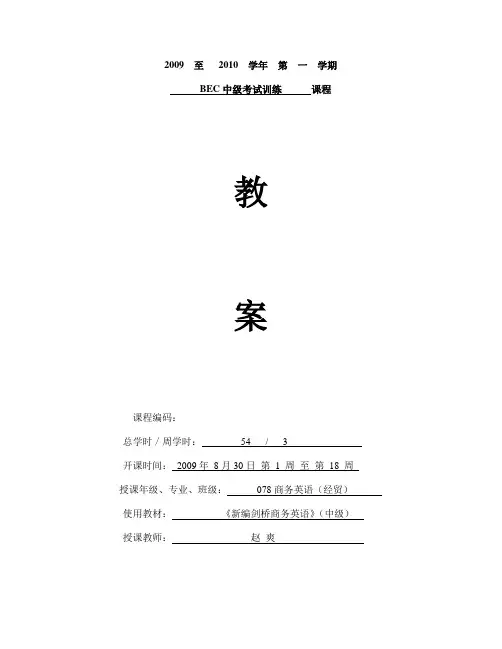
2009 至2010 学年第一学期BEC中级考试训练课程教案课程编码:______________________________________总学时/周学时:54 / 3开课时间:2009年8月30日第 1 周至第18 周授课年级、专业、班级:_ _078商务英语(经贸)______ 使用教材:《新编剑桥商务英语》(中级)授课教师:赵爽Introduction of BEC1.FULL NAME OF BEC: Business English Certificate (run by Cambridge )2.Three Levels of BEC: Preliminary, Vantage, Higher3.Contents of Each Test: Listening, Reading, Writing, Speaking4.The Certificate of BEC can be admitted in most countries and most overseas-invested enterprise5. No expiry dateTips of BEC•The examination places in Tianjin:1.天津大学研究生院,电话(022)27406406, 天津市卫津路92号, 邮编300072。
2.天津财经大学经济贸易外语系,电话(022)28171431,28340028天津市河西区珠江道25号,邮编300222。
•Examination time: May 20th higher, May27th preliminary, June 3th vantage •Deadline of Entering time: March 10th, September 15th•Examination fee of BEC Vantage: approximately 500 RMBUnit 1A TeamworkObjectives & requirements1.To enable students to talk about teams and teamwork2.To practice reading for gist and specific information3.To enable students to make and to change arrangementsImportant & difficult points1.Correct reading method2.V ocabulary of psychologyrmation how teamwork can help their class prepare for the Cambridge BECexamApproaches and methods: Task pattern; Pair work & group workEquipments: Tape recorder; over-head projector, screenContents1.Warming-up questions:Discuss the requirements for successful teamwork in pairsHow to improve teamwork?The following may give you some hintsGeneral ideasFriendly atmosphereNot bossyPatientGood mannersModestLeadershipGood interpersonal skillsVariety of experienceCan you give us some reasons why the above points can improve teamwork?2.How to make your opinion more convinced? The following are two examples variety of experience1. Variety of experience and a board horizon would help to tackle urgent matters and establish his or her personal prestige. Well- experienced staff are capable of overcoming storms and crises.2. A wide range of experiences are important to a team member, because you never know what kind of problems might suddenly come up to you. Experiences in different fields will enhance the chance of successfully sorting out the problem with your knowledge, which is based on your past experience.Examples of widen the opinionLeadership: on coming across problematic issues, new or inexperienced staff usually will feel depressed and even start to panic. One or a number of experienced staff will , in this kind of situation, automatically become the spiritual leaders of the team and can get the issues in question solved quickly.3.Reading part on Page 8---answer the following questions1. What did Cussons do?Brought in 3 expatriate managers to work with the local sales staff in project team.Also brought a consultant organizing 2 one-week courses working on building and developing creative thinking.2. What benefits did this bring?Cussons has seen financial benefits, reporting savings of 200,000 pounds from the first course and expected saving s of 700,000from the second.The courses have also allowed the participants to measure progress against targets set on the course and have made people excited about their jobs.Unit 1B communicationObjectives & requirements1. To enable students to leave telephone messages2. To raise awareness of clarity in spoken language3. To practice reading for gist and specific informationImportant & difficult pointse of various forms of communication.2.V ocabulary of psychology3.discuss the difficulties of understanding spoken English.Approaches and methods: Task pattern; Pair work & group workEquipments: Tape recorder; over-head projector, screencontents4.Pre-question: Imagine what kind of communications will you use frequently at work? Faxes, letters, e-mails, phone calls, memos, notes etc.5.Some points in article on page 121.Approach: way leading to sth.2.Idiomatic: in accordance with the particular nature or structure of a language,dialect3.Insensitive: not realizing how other people feel4.Interpret: explain sth which is not easily to understand6.Answer the questions on Page 111.Because English is the dominate language of international communication.2.Make their message simple, use shorter chunks, keep one idea per sentence, speakmore slowly, and not raise their voice.3.As English is spoken in their work environment, they do not have to understand otherlanguage themselves.4.Through language and cultural awareness seminars.●听力8选5解题步骤1.简单中文标A---H含义2.听力过程中抓重点句子或关键性词语3.听完叙述再做答4.再听一边纠正错误●Pay attention to the key wordsTypescript1:•Hello, this is Margaret Brock here. It is 9.30 on Wednesday morning. I am ringing about the half-year sales report. Could you send me a copy of your department’s figures, please? I am in Helsinki until Friday. Thanks very much. Bye.Typescript2•This is Frank Larsen from Scandinavian Conferences in Copenhagen. I am ringing to tell you tha t this year’s Danish Telecommunications Trade Fair’s taking place in the week ofNovember22. if you’d like some complimentary tickets, please let me know how many you’ll need. Please call me on004533346766.Thank you. Bye.Typescript3•Hi, Frida. It’s Sue Me llor. How are you?I hope you’re not too busy at the moment. I wanted to talk to you about my visit next month. You know we’d talked about the 13th? Well, I’m afraid it’s not going to work out because of deadlines here. I don’t suppose we could put it back a week or so, could we? Give me a ring and let me know. Thanks. Typescript4•Hi Frida. It’s Colin. I am on my mobile because I am traveling to a meeting with a client but I need to talk to you urgently so could you call me on 0486 772 444? It’s my mobile nu mber. I need to talk to you about that contract we’re trying to get in Helsinki because the customer accepted our proposal and I need to know whether it’s all right if I just go ahead and sign the contracts or whether you want to get involved, as well. Could you get back to me asap? Thanks.Typescript5•Hello, Frida. It’s Steve Montgomery here. I got your proposal for the product launch and I’ve finally managed to get a look at it. It looks OK, but I think there could still be one or two minor problems with it. I think the time schedule looks a bit on the optimistic side, as well.I've got a couple of suggestions, which I’ll get off to you today. Let me know what you think, OK?bye.●听力填空题做题步骤1.打电话所找的人肯定不在场2.此类题没有陷阱听到什么填什么就可以3.每个空先单词的首字母把所填内容记下4.最后整理成完整的答案5.人名、地名等按照拼规律填Unit 2a entertaining clientObjectives & requirements1. To enable students to leave telephone messages2. To raise awareness of and practice techniques for encouraging conversation3. To practice reading for gist and specific informationImportant & difficult points1.describe the most memorable restaurant they have been to2.V ocabulary of psychology3.Listen and match five short pieces where people talk about business trip with thequestions the people answer.Approaches and methods: Task pattern; Pair work & group workEquipments: Tape recorder; over-head projector, screenContents●Pre-question: you are going to give one of your friends a treat, what kind ofrestaurant you’d like to choose? If you entertain a business contact, what would you do?You may pay attention to following points when choosing restaurant:1.Location2.Atmospherefort4.Cleanliness5.Staff friendliness/attentiveness6.Speed of service7.Quality of food/drink8.Value for money●Read the advertisement about Ports English Restaurant.Would porters be a suitable restaurant in situations on page 20.1.Words explanation2.Interior: a part, surface, or region that is inside or on the inside3.enhance: to intensify or increase in quality, value, power,4.Distinctive: serving or tending to distinguish5.Cater: to provide what is required or desired (for)6.Presentation: the act of presenting or state of being presentedUnit2b corporate hospitality---speaking partmixing business with pleasure7.select suitable entertainment for each following group and give reason to supportyour choice. Discuss this program in 4-people group.8.Are there other ways to entertain clients?Unit2b corporate hospitalityObjectives & requirements1.To enable students to talk about corporate hospitality2.To practice reading for gist and specific information3.To review language for making and dealing with invitationsImportant & difficult points1.Correct reading method2.V ocabulary of psychology3.discuss the advantages and disadvantages of mixing business with pleasure. Approaches and methods: Task pattern; Pair work & group workEquipments: Tape recorder; over-head projector, screenContents●select suitable entertainment for each following group and give reason to supportyour choice. Discuss this program in 4-people group.●Are there other ways to entertain clients?●Oral practiceWHAT IS IMPORTANT WHEN…?ENTERTAINING CLIENTSTYPES OF ACTIVITIES( how to choose )COST (how to arrange)Types of ActivitiesEntertaining client is done by way of a series of activities. Such as a sightseeing tour, a football match, a ballroom party, an orchestra performance, a ballet show, a fashion show, playing tennis and a formal meal, etc.The activities that you choose will constitute a part of the first impression that you will give to your clients. So you should be careful when choosing the type of activities. You need to consider the client’s age, educational and cultural backgrounds and do some research about your clients’ characters and hobbies.The costs of entertainmentNot always the essential thing. Depending on the nature/characteristics of the transaction or the size of the deal.Should consider the profit issue. If the company is expecting to make big gain/profits out of a specific client, it should at least put in proportional investment to entertain/please its clients. E.g.….If the company foresees that the client is not very lucrative, then….The ideal plan would be spending as little money as possible to get the deal done. But you must not offend your clients. You should make them feel being welcomed.Types of ActivitiesFor well-educated clients, they may expect some high class-associated activities, such as ballet, ballroom parties, and orchestra performances. If you fulfill their expectation/standard, your efforts will put a lot of weight on your credibility.For some young clients, you may wish to take them to some more fashionable activities, such as a music bar, a pop music show, a fashion show.For those sporty clients-football, tennisHowever, you should always end up all kind of activities with having a formal meal. You don’t want to talk about business with your clients in the tennis court or theatre; they are just the warming-up activities for the key matter-business. After a whole day or a few days’ entertainment, you may find the distance between the two sides are much narrower than the beginning, and there might be a lot of things that you both want to talk about.●Points in the article1.Intimate: having or being a very close and friendly relationship2.Chit-chat: chatting sth. Unimportant3.Bring up: call attention to sth.4.Recipe: method of achieving sth.5.Effortlessly: easily●Memo & message1.动笔之前仔细审题2.明确自己在材料背景中的身份3.吃透考题要点,面面俱到4.切忌节外生枝、画蛇添足ExercisesTo: all section headsThere are eight vacancies on training courses being given in May and June. The courses provide useful training for junior staff in computers, time management and other aspects of modern office work. Could you kindly recommend suitable staff?ExercisesYou work for a company which produces laser printers. You are visiting another company, Microsoft, to buy some computer software for your department. They have expressed an inte rest in your company’s printers and you would like to take twenty brochures and three sample printers with you.* write a short note to Mr. Jim Asana, the sales manager.*ask for his permission to take these items.*explain why you want them.*mention the time and date when you want to collect them*write 30-40 words on your answer Sheet.ExercisesThe refrigerator in the kitchen of the office is full and has to be cleaned. You are the office director.*write a short memo in 40-50 words*tell the office staff the time of housecleaning.*tell them to deal with their own food*warn them that if not taken away, the food will be thrown away.Unit3A Ordering goodsObjectives & requirements1.To enable students to talk about and changing orders2.To practice reading for gist and specific information3.To raise awareness of clarity in writing and useful phrases for letter writing Important & difficult points1.Correct reading method2.V ocabulary of psychology3.discuss ways of improving the clarity of the fax.Approaches and methods: Task pattern; Pair work & group workEquipments: Tape recorder; over-head projector, screenContentsImproving fax on page 32:yout: the layout is too dense and therefore off-putting. It might help if the writer used headings, bullet points and brackets.2.paragraphs:the text needs to be divided into paragraphs to aid clarity and to encourage the reader to read it .4.Connectors: it is difficult to follow the sequence of ideas because connectors are notused much to make it clear.5.Sentences: some sentences are too long, making the text difficult to read.6.Accuracy: as the writer is a non-speaker, complete accuracy is perhaps not to beexpected. However, core words should be spelt correctly.●商务写作总原则(6Cs)1.Correctness:恰当的语言风格,准确的措辞信息,正确的语法标点2.Clarity:逻辑布局-因果,时间,序列,比较等等合理的构架句群与段群:各类句型最佳组合3.Conciseness:现代商务英语发展趋势We began to export our goods to countries abroadWe began to export our goods.We require furniture which is of the new type.We require new-type furniture.4.Concreteness:商务写作尽量使用具体、明确的语言,切忌笼统模糊。
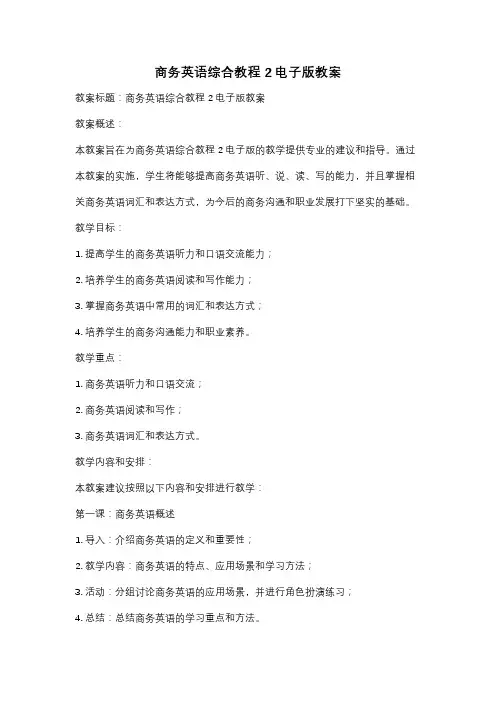
商务英语综合教程2电子版教案教案标题:商务英语综合教程2电子版教案教案概述:本教案旨在为商务英语综合教程2电子版的教学提供专业的建议和指导。
通过本教案的实施,学生将能够提高商务英语听、说、读、写的能力,并且掌握相关商务英语词汇和表达方式,为今后的商务沟通和职业发展打下坚实的基础。
教学目标:1. 提高学生的商务英语听力和口语交流能力;2. 培养学生的商务英语阅读和写作能力;3. 掌握商务英语中常用的词汇和表达方式;4. 培养学生的商务沟通能力和职业素养。
教学重点:1. 商务英语听力和口语交流;2. 商务英语阅读和写作;3. 商务英语词汇和表达方式。
教学内容和安排:本教案建议按照以下内容和安排进行教学:第一课:商务英语概述1. 导入:介绍商务英语的定义和重要性;2. 教学内容:商务英语的特点、应用场景和学习方法;3. 活动:分组讨论商务英语的应用场景,并进行角色扮演练习;4. 总结:总结商务英语的学习重点和方法。
第二课:商务英语听力训练1. 导入:复习商务英语的基本词汇和表达方式;2. 教学内容:商务英语听力技巧和常见场景的听力练习;3. 活动:分组进行商务英语听力练习,并进行听后讨论;4. 总结:总结商务英语听力技巧和常见场景。
第三课:商务英语口语交流1. 导入:复习商务英语的口语表达方式;2. 教学内容:商务英语口语交流技巧和常见场景的口语练习;3. 活动:分组进行商务英语口语练习,并进行角色扮演练习;4. 总结:总结商务英语口语交流技巧和常见场景。
第四课:商务英语阅读和写作1. 导入:复习商务英语的阅读和写作技巧;2. 教学内容:商务英语阅读和写作的常见场景和技巧;3. 活动:分组进行商务英语阅读和写作练习,并进行互评;4. 总结:总结商务英语阅读和写作的技巧和常见场景。
第五课:商务英语词汇和表达方式1. 导入:复习商务英语常用词汇和表达方式;2. 教学内容:商务英语常用词汇和表达方式的扩充和应用;3. 活动:进行商务英语词汇和表达方式的练习和应用;4. 总结:总结商务英语常用词汇和表达方式的扩充和应用。
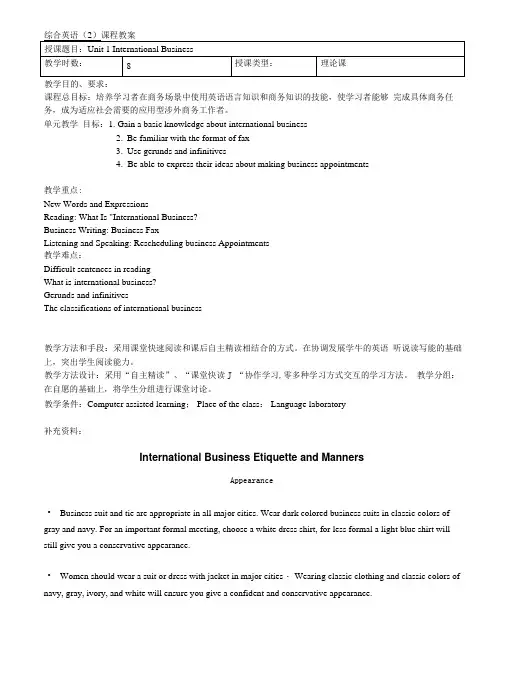
综合英语(2)课程教案教学目的、要求:课程总目标:培养学习者在商务场景中使用英语语言知识和商务知识的技能,使学习者能够完成具体商务任务,成为适应社会需要的应用型涉外商务工作者。
单元教学目标:1. Gain a basic knowledge about international business2.Be familiar with the format of faxe gerunds and infinitives4.Be able to express their ideas about making business appointments教学重点:New Words and ExpressionsReading: What Is "International Business?Business Writing: Business FaxListening and Speaking: Rescheduling business Appointments教学难点:Difficult sentences in readingWhat is international business?Gerunds and infinitivesThe classifications of international business教学方法和手段:采用课堂快速阅读和课后自主精读相结合的方式。
在协调发展学牛的英语听说读写能的基础上,突出学生阅读能力。
教学方法设计:采用“自主精读”、“课堂快读J “协作学习,零多种学习方式交互的学习方法。
教学分组:在自愿的基础上,将学生分组进行课堂讨论。
教学条件:Computer assisted learning; Place of the class: Language laboratory补充资料:International Business Etiquette and MannersAppearance•Business suit and tie are appropriate in all major cities. Wear dark colored business suits in classic colors of gray and navy. For an important formal meeting, choose a white dress shirt, for less formal a light blue shirt will still give you a conservative appearance.•Women should wear a suit or dress with jacket in major cities・ Wearing classic clothing and classic colors of navy, gray, ivory, and white will ensure you give a confident and conservative appearance.教学内容及过程:Teaching Procedures:l st_4th period*Lead-in:p-1Activity 1: work in pairs. Talk about the international business activities shown in the pictures below.Activity 2: work in pairs. Discuss what type of international business the following organizations or enterprises are engaged in.Activity 3: work in pairs, and discuss the following questions.a.what caused international business?b.In what aspects can we fined the impact of business globalization?c.What is the greatest contribution foreign investment makes to a country?*Before-reading:p. 3 Before you read, discuss the following questions.1.What is international business in your opinion?2.How does international business benefit us?• While-reading:Difficult words:portfolioset of investments (eg stocks and shares) owned by a person, bank, etc (个人、银彳亍等所有的)投资组合(如债券和股票):My stockbroker manages my portfolio for me.我的证券经纪人替我管理投资纽合.* [attrib作定语]portfolio management投资组合管理subsidiaryZ7 subsidiary thing, esp a business company 附属事物;(尤指)附属公司.en trepreneurperson who starts or organizes a commercial enterprise, esp one involving financial risk 企业家(尤指涉及财务风险的):He would not have succeeded in such a risky business if he had not been such a clever entrepreneur.假若他不是那麽楮明强干的企业家,就不会在这样冒险的事业中取得成功globalization (UK USUALLY -isation)the increase of trade around the world, especially by large companies producing and trading goods in many different countries:We must take advantage of the increased globalization of the commodity trading business.Difficult sentences:Part I1.In its purist definition, international business is described as any business activity that crosses national boundaries. 国际贸易最原始的含义是指一切跨越国界的商务活动。
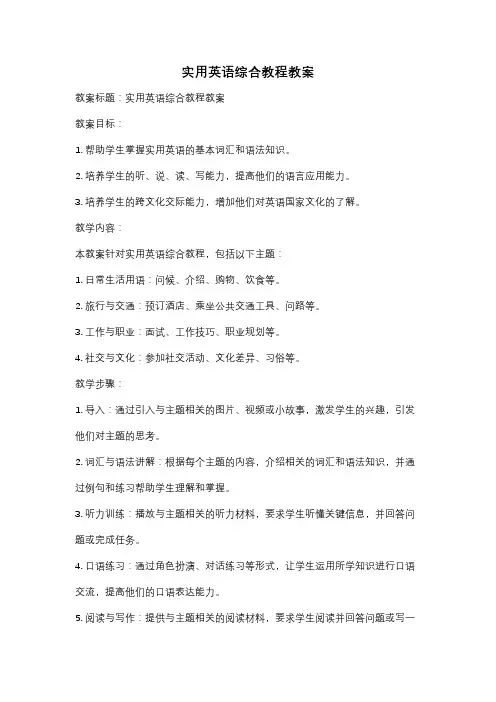
实用英语综合教程教案教案标题:实用英语综合教程教案教案目标:1. 帮助学生掌握实用英语的基本词汇和语法知识。
2. 培养学生的听、说、读、写能力,提高他们的语言应用能力。
3. 培养学生的跨文化交际能力,增加他们对英语国家文化的了解。
教学内容:本教案针对实用英语综合教程,包括以下主题:1. 日常生活用语:问候、介绍、购物、饮食等。
2. 旅行与交通:预订酒店、乘坐公共交通工具、问路等。
3. 工作与职业:面试、工作技巧、职业规划等。
4. 社交与文化:参加社交活动、文化差异、习俗等。
教学步骤:1. 导入:通过引入与主题相关的图片、视频或小故事,激发学生的兴趣,引发他们对主题的思考。
2. 词汇与语法讲解:根据每个主题的内容,介绍相关的词汇和语法知识,并通过例句和练习帮助学生理解和掌握。
3. 听力训练:播放与主题相关的听力材料,要求学生听懂关键信息,并回答问题或完成任务。
4. 口语练习:通过角色扮演、对话练习等形式,让学生运用所学知识进行口语交流,提高他们的口语表达能力。
5. 阅读与写作:提供与主题相关的阅读材料,要求学生阅读并回答问题或写一篇短文,锻炼他们的阅读理解和写作能力。
6. 文化交流:通过介绍英语国家的文化习俗、音乐、电影等,增加学生对英语国家文化的了解,培养他们的跨文化交际能力。
7. 综合练习:设计综合性的练习,包括听、说、读、写等多个方面,让学生综合运用所学知识,提高他们的语言应用能力。
8. 总结与反馈:对本节课的学习进行总结,并给予学生反馈,鼓励他们的努力并指出需要改进的地方。
教学评估:1. 课堂表现:观察学生在课堂上的参与度、表达能力和合作精神。
2. 作业评估:批改学生的书面作业,评估他们的语法和写作能力。
3. 测验:设计与教学内容相关的听力、口语、阅读和写作测验,评估学生的综合语言能力。
教学资源:1. 教材:实用英语综合教程教材及配套练习册。
2. 多媒体设备:投影仪、音响设备等,用于播放听力材料和展示教学资源。
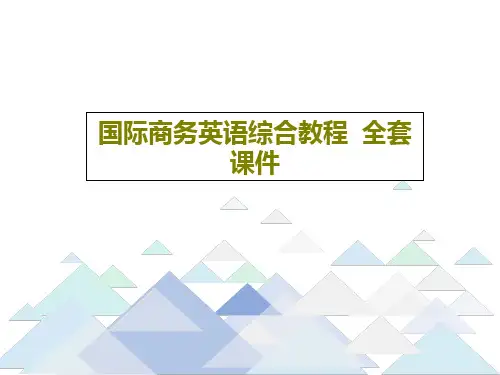
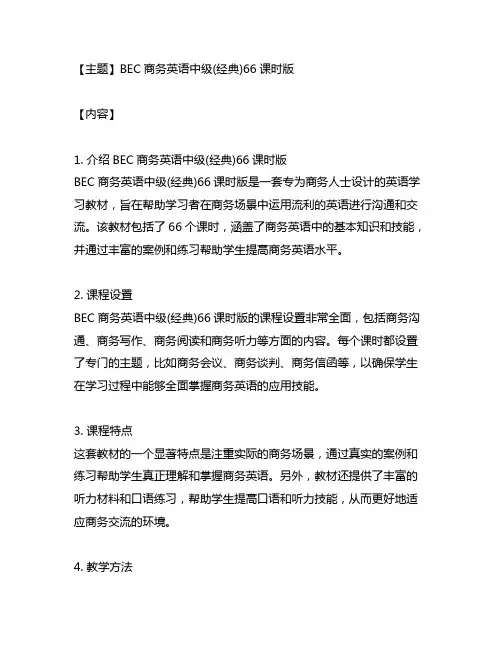
【主题】BEC商务英语中级(经典)66课时版【内容】1. 介绍BEC商务英语中级(经典)66课时版BEC商务英语中级(经典)66课时版是一套专为商务人士设计的英语学习教材,旨在帮助学习者在商务场景中运用流利的英语进行沟通和交流。
该教材包括了66个课时,涵盖了商务英语中的基本知识和技能,并通过丰富的案例和练习帮助学生提高商务英语水平。
2. 课程设置BEC商务英语中级(经典)66课时版的课程设置非常全面,包括商务沟通、商务写作、商务阅读和商务听力等方面的内容。
每个课时都设置了专门的主题,比如商务会议、商务谈判、商务信函等,以确保学生在学习过程中能够全面掌握商务英语的应用技能。
3. 课程特点这套教材的一个显著特点是注重实际的商务场景,通过真实的案例和练习帮助学生真正理解和掌握商务英语。
另外,教材还提供了丰富的听力材料和口语练习,帮助学生提高口语和听力技能,从而更好地适应商务交流的环境。
4. 教学方法BEC商务英语中级(经典)66课时版采用了多种灵活的教学方法,如教师授课、小组讨论、角色扮演等,以激发学生的学习兴趣,增强学习效果。
教师在教学过程中还会根据学生的实际情况进行个性化指导,以确保每个学生都能够充分理解和掌握所学内容。
5. 学习效果经过学习BEC商务英语中级(经典)66课时版,学生将能够熟练地运用商务英语进行口头和书面沟通,能够处理各种商务场景下的交流和沟通,比如商务会议、商务洽谈、商务函电等。
学生的听力和口语能力也会得到显著提高,更有利于在真实的商务环境中表现出色。
6. 总结BEC商务英语中级(经典)66课时版是一套全面、实用的商务英语教材,适合有一定英语基础的商务人士学习。
通过系统的学习,学生能够提高商务英语能力,增强在商务交流中的竞争力,为自己的事业发展打下坚实的语言基础。
在今天的全球化商务环境中,掌握流利的商务英语已经成为职场人士必备的技能。
而BEC商务英语中级(经典)66课时版作为一套经典教材,为学习者提供了全面的商务英语学习和实践机会。
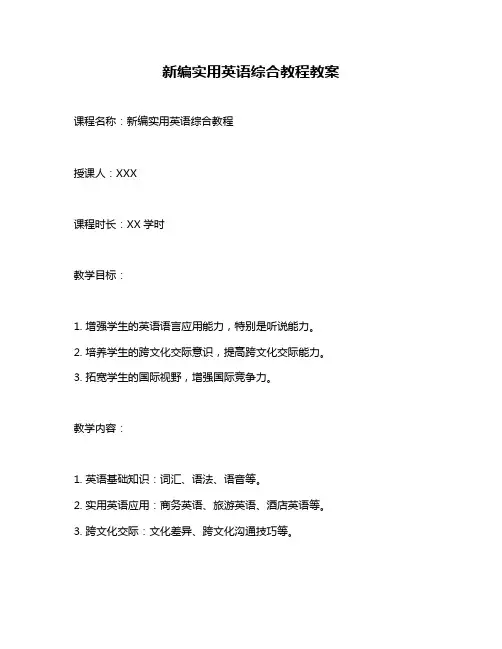
新编实用英语综合教程教案课程名称:新编实用英语综合教程授课人:XXX课程时长:XX学时教学目标:1. 增强学生的英语语言应用能力,特别是听说能力。
2. 培养学生的跨文化交际意识,提高跨文化交际能力。
3. 拓宽学生的国际视野,增强国际竞争力。
教学内容:1. 英语基础知识:词汇、语法、语音等。
2. 实用英语应用:商务英语、旅游英语、酒店英语等。
3. 跨文化交际:文化差异、跨文化沟通技巧等。
教学难点与重点:难点:如何将英语基础知识与实际应用有效结合,提高学生的英语应用能力。
重点:跨文化交际能力的培养,以及如何增强学生的国际竞争力。
教具和多媒体资源:1. 投影仪、电脑、音响等多媒体设备。
2. 英语教材、练习册、听力材料等。
3. 跨文化交际案例、图片、视频等教学资源。
教学方法:1. 讲授法:讲授英语基础知识,如词汇、语法、语音等。
2. 案例分析法:通过分析实际案例,让学生了解跨文化交际的实际情况。
3. 小组讨论法:组织学生进行小组讨论,提高口语表达和交流能力。
4. 角色扮演法:通过角色扮演,模拟实际场景,提高学生的英语应用能力。
教学过程:1. 导入(5分钟):通过提问导入,检查学生预习情况,引起学生的兴趣。
2. 讲授新课(45分钟):讲解英语基础知识和实用英语应用,结合案例分析,引导学生思考。
3. 巩固练习(20分钟):组织学生进行小组讨论、角色扮演等活动,巩固所学内容。
4. 归纳小结(10分钟):总结本节课的重点内容,对学生的表现进行评价,给出建议和指导。
评价与反馈:1. 设计评价策略:通过课堂表现、小组讨论、角色扮演等活动,以及课后作业和测试等形式进行评价。
新剑桥商务英语中级教学设计一、教学目标新剑桥商务英语中级教学旨在培养学生具备以下能力:1.能顺利进行商务对话,并理解他人的意图和表达;2.能够撰写商务邮件、简报和报告;3.能够处理商务状况下的沟通和协商;4.能够赢得商务场合下的信任和合作。
二、教学内容本课程将涵盖以下主题:1.商务会议和交流2.商务通信和写作3.商务文化和礼仪4.商务旅行和接待三、教学方法本课程采用多种教学方法,包括讲授、小组讨论、角色扮演、实践训练等形式,帮助学生掌握商务英语基本技能。
讲授讲授环节是本课程的基础,通过讲解商务英语的词汇和语法,帮助学生深入了解商务沟通的精髓。
小组讨论小组讨论能够激发学生积极性,让他们在团队中交流和分享商务英语学习心得和经验。
角色扮演在角色扮演环节,学生可以运用所学语言技能,在虚拟的商务场合中模拟真实的沟通和交流过程,锻炼表达和听取的能力。
实践训练本课程内容均设有实践环节,学生在模拟商务场合中应用所学技能,通过实践训练巩固知识点。
四、教学评价本课程用多种方式对学生成绩进行评价:1.平时成绩:包括出勤率、小组讨论、作业和课堂表现等因素;2.期中考试:主要考察学生对商务英语语法、词汇等方面的掌握程度;3.期末考试:综合考察学生对商务英语各方面知识的掌握,包括听力、口语、阅读和写作等;4.实践考核:针对学生在模拟商务场合中的表现、掌握的实际应用技能以及高效的合作能力等综合考核。
五、教学建议1.提前对学生进行商务英语基础测试,以确保学生的英语水平符合本课程要求;2.学生在学习期间需要积极参与课堂讨论、角色扮演等活动,促进英语口语和表达能力的提升;3.教师需要耐心地辅导学生,激励和鼓舞学生的学习热情,帮助他们克服英语学习上的阻碍;4.教师应该注意语言技能和文化背景差异,在教学中注重培养学生对商务文化和礼仪的了解。
Introduction & Unit 1a Teamwork (1)Objective: make students get to know basic information about Cambridge BEC vantage and talk about teamwork Focus on : to talk about teamworkIntroduction about the examThe exam comprises four tests: reading, writing, listening and speaking. The Speaking Test date is decided after your entry is confirmed by Cambridge. Candidates will receive an overall grade and separate grade for each test. (Pass grades A,B,C or Fail grades D,E).How to understand, record and build vocabulary Advise students to adopt following ways on vocabulary Ways to understand new words1. Examine the context of the worda. the contextb. b. the position of the word2. Examine the word itselfa. prefixes (e.g. inter-, un-, bi-)b. suffixes(e.g. -ee, -tion, -ical)3. Use a dictionary or website (e.g. , or)Ways to record new words1. in the margin of your course book2. on a separate sheet of paper3. in a vocabulary notebook4. on a computer5. on cardsWays to build vocabulary1. compound words2. using prefix and suffix3. synonym and antonym4. put words in a logical orderAssessing teamsSpeakingStep1 choose the five most important characteristics of a good team and put them in orderStep2 pair work. Conduct a dialogue about teamwork.Question: What is a good team?Do you work in a good team?Do you like your team members?Why or Why not?Dialogue tips: One can express his view about teamwork in terms of one’s experience in the working place, the sports team, or one’s family or class.Word tips: Co-operative 齐心协力的have communication problems 交流有问题attach importance to team-building 重视团队建设develop team work 开拓团队协作an effective team 精锐团队share the same values 具有相同的价值观HomeworkRead the following quotes and proverbs about team work. Henry FordComing together is a beginning.Keeping together is progress.Working together is success.Bruce Coslet, Coach, BengalsThe era of the rugged individual is giving way to the era of the team player.Everyone is needed, but no one is necessary.Vince Lombardi, football coach for the NFL (1913-1970) Teamwork is what the Green Bay Packers were all about. They didn't do it for individual glory. They did it because they loved one another…Susan Gerke, IBM, Leadership DevelopmentConflict is inevitable in a team ... in fact, to achieve synergistic solutions, a variety of ideas and approaches are needed. These are the ingredients for conflict.Benjamin FranklinWe must all hang together,or assuredly, we shall all hang separately.Thomas Edison, when asked why he had a team of twenty-one assistantsIf I could solve all the problems myself, I would.Lewis B. ErgenThe ratio of We's to I's is the best indicator of the development of a team.Unit 1a Teamwork (2)Objective: to enable students to talk about teamwork Focus on : to learn some useful phrases to make and change arrangementsReadingStep 1 introduce background information and explain some new wordsNewsreport structure: headline, lead and body. The topic sentence usually appears in the headline and lead.Step 2 Read the article, try to get the main idea and finish the exercises.Step 3 Ask students to present answers and correct the answers together.VocabularyStep 1 do the match work and check the answerStep 2 Ask students to use the phrases to describe what happened at Cussons in Poland. Practice personally or in pair.Step 3 Ask one student to make presentation and correct the mistakes after it.SpeakingStep 1 Group work: discuss how teamwork can help your class prepare for the Cambridge BEC Vantage. Step 2 Students can form group of no more than 4 persons and conduct a discussion.Encourage everyone to speak and contribute to the discussion.Time limit: Five minutesStep 3 After the discussion, ask each group to choose a representative and make a summary to the whole class.Word tips: work in a team团队合作share ideas 交流想法help each other with homework 做作业相互帮忙test each other on texts covered 对已学的课文相互检测e-mail each other 相互发电子邮件learn from one’s strong points 学人所长Arranging a courseReadingStep1 Read the questions before reading and look for the specific information while readingStep 2 Ask students to answer the questions and correct the mistakes.Step 3 Explain some language points and new words.SpeakingPair work 1Step 1 Learn some useful phrases to make and change arrangementsStep 2 Look at the activity sheets and get to know the requirement and allocate roles.Step 3 Make up a dialogue and practice it in pairs.Step 4 Ask some pairs to present the dialogue in front of the class.Step 5 Correct the mistakes and give some comments.Pair work 2Step 1 Look at the advertisements for the team-building courses below.Step 2 Explain some language points and new words. Step 3 Ask the students to answer the questions and check the answers.TeamworkPlay a game on teamwork and experience the importanceof cooperationHomeworkremember the useful phrases and finish self-study 1a -How about/what about the following week?-Shall we say 8 Feb.?-When would you suit you?-I ‘m afraid I can’t make it then.-They’re working on another project until 12 Feb.Unit 1 b CommunicationObjective:to improve communication in spoken language and grasp the main idea and specific information during reading and listening.Focus on:to learn to leave and take voicemail messages.Keeping on touchSpeakingStep 1 Pair work. Ask your partner questions about the forms of communication and mark them on the graph. Step 2 Discuss the advantages and disadvantages of each form of communication with your partnerStep 3 Ask some pairs to present the dialogue to the whole class and correct the mistakes they make.Word tips: snail mail 传统的信件Time-consuming 费时Save time/trouble 省时间,方便Raise the efficiency in your work 提高工作效率In written form 书面形式Refer to it any time you like 你随时可拿来参考ReadingStep 1 Read the article about using English for international business, looking for the topic sentence and the key words and give a title to each paragraph.Step 2 Answer the questions about the article and check the answers.Step 3 Explain the title and some new words and useful expressions.Limit themselves to 把…限制在…Insist on/upon sth / doing sth 坚持Culture-specific 文化特有的SpeakingStep 1 Discuss with partner:Questions: what do you find difficult about understanding native English speakers?Do you such experiences?Do you have any suggestions to improve communication with foreigners?Step 2 Ask some pairs to present their dialogue and correct the mistakes and make some commentsWord tips: the fast speed makes it hard to follow 语速太快Local accent 地方口音Idiomatic language 俗语Slang 俚语jargon 行话Cultural difference 文化差异Cultural-specific humor 文化特有的幽默Leaving voice mailListening 1Step 1 read the requirement of the exercise and guess the content of the five voice mailStep 2 Listen to the tape and try to match the right items Step 3 Listen to the tape again and check the answers Step 4 Listen to the tape for a third time while reading the typescripts and correct the answers.SpeakingStep 1 Discuss with your partner : which call do you find most difficult to understand and why?Step 2 Make the difficult message easier to catch and present the adaptation to the whole class.Step 3 Give suggestions to make yourself more easily understood: use simple English, one point one sentence.Taking messagesListening 2Step 1 Look at the two forms and guess the main idea of the callStep 2 Listen to the tape and look for the specific information to fill the blanks.Step 3 Listen to the tape again and check the answers Step 4 Listen to the tape for a third time while reading the typescripts and correct the answers.SpeakingStep 1 Learn some useful phrases to leave and take messages.Step 2 Look at the activity sheets and get to know the requirement and allocate roles.Step 3 Make up a dialogue and practice it in pairs.Step 4 Ask some pairs to present the dialogue in front of the class.Step 5 Correct the mistakes and give some comments.HomeworkSelf-study 1 b and remember some useful sentences to take and leave messages-I’m afraid she’s not here today. Can I help you/ take a message?-Could I ask who’s calling? Could you give me your fax number, please?-I ‘ll give her the message as soon as she’s back.-I am ringing about the sales report.-Could you please call me back?Unit 2a Entertaining a client (1) Objective:To enable Ss to talk about the critiria of restaurantsFocus on: To practice reading for specific informationChoosing a restaurantReading 1Step 1 Warming-up exercise:questions: When you invite your friend to have dinner, where would you choose?If you invite am important person for a meal, where would you choose? What is your requirement for a good restaurant?Step 2 After the students have a brianstorming, ask them to see the lists of criteria on the customer satisfaction form.Step 3 Pair work. Have a discussion with your partner and decide on the three most important criteria for them.Step 4 Ask some pairs to present the dialogue to the whole class and correct the mistakes they make.SpeakingPair Work. Ask each other about the last restaurant they visited. Try to descirbe the restaurant in terms of the critia mentined above. They are required not to use “satisfactory”“excellent”and”poor”in their dialgue. Instead they should use other similar words to descibe and thus expand their range of vacabulary.Word tips: spendid,magnificent,neat, elegant,amiable,consideratedirty, untidy,cold, impatientheavy, lightCould you tell me something about…?How is the ….?What is your impression of….?Reading 2Step 1 Ask students to look at the advertisement for Poters English Restaurant in London.Step 2 Ask students to indentify the ctiria the customer satisfaction form referred to and what food they would expect this restaurant to serve and what kind of customers this restaurant is suitable for.Step 3 Ask students to see the five situations below the advertisement and decide whether Porters is good for their choice and explain why based on the main feature or distinction of the restaurant.Explain language points:1 objective: 目标、宗旨The objective of the new organization is to provide fee legal service to the poor.2 be popular with: 受欢迎的、招人喜欢的Swimming is popular with all ages.a popular resort, a popular food, popular song3 pride oneself on/upon 以…为豪He prides himself on his success in painting.4 to cater forHe runs a restaurant which caters for weddings and parties.5 call in: 顺路到某处Call in on your way home and tell me how the interview went.SpeakingPair work. Ask your partner to describe the most memorable restaurant he/she has ever been to and present the dialogue to the whole class.Word tips:What makes my dining experience stand out is….Enjoy the attractive and relexing atmosphere.Cater to different tastesHave a feeling of friendliness and comfort.The classical interior design serves as a visual feast.Homeworkthe exercise of self-study 2aread the supplementary material attached about table manner.Unit 2a Entertaining a client (2) Objective:To enable Ss to practise techniques for encouraging conversationFocus on: To practice listening for specific informationMaking converationListening 1Step 1 Ask students to look through the questions in theright and guess what would be the answers.Step 2 explain the difference between “trip”and “journey”Step 3 listen for the first time and try to get the main idea Step 4 Listen for the second time and concentrate on the useful and key words. Such as “bed”“sleep”“delay”“luggage” and etc.Step 5 match the answers with the questions. Listen to the tape while reading the tapescripts and check the answer.Language points:1. I got stopped at 我在…被卡住了2. I wouldn’t mind doing 我不介意干….3. get through quite a lot 经历了很多4. It was a bit too heavy. 太油腻了5. a long way from a decision 作决定还早Listening 2Listen to the dialogue carefully and indentify the phrases and expressions used by the first speaker to encourage the converation. Ask students to contribute more by themselves.Speaking 3Step 1 pair work. Ask students to develop the five statements into conversation, using the techniques from the Don’t forget section where appropriate.Step 2 Ask volunteers to present the dialogue and make some comments.Speaking 4Step 1 Explain the rule carefully to students. Students should from groups of 4 and play the game. We will use two coins to decide the steps that one should move. Students should throw the coins in turn to start and moveas the rule says. When a player lands on a sqare she should tak about the topic for one minute. The others should encourage her to talk further until the conversation goes for one minute. When a player lands on a “free choice”one of the other player should chooses a topic and asks a suitable initial questions to set the speaker talking. The first person reaches the “Finish” wins.Step 2 Divide the students into groups of 4 and make sure they understand the rules. Begin the game and walk around to check their play.Step 3 Make the winners stand out and give them encouragement and awards.Additonal situational conversationSet the situation: Suppose you were an assistant of a sales manager. One day your boss told you he was going to invite two important clients to have dinner. He asked you for your recommendation and suggestion since youare in charge of making reservation and business trip arrangement and have kept a lot of information about hotels and restaurants. Your boss made a decision after discussing with you. He asked you to make reservation with the restaurant he confirms. You called the hotel and made reservation according to your boss’s requirement. Allocate roles to the students and explain the requirement. Students form groups of three and begin the role-play. Check their practice and encourge them to be creative and make this role-play vivid.Ask two groups to perform the role-play and make some comments.Homeworkexam praticeremember the expressions used to encourage conversation:--Really?--I’m surprised to hear that.--What did you think of….?--So the meeting’s been postponed until next March.Unit 2b Corporate hospitalityObjective:To enable Ss to talk about corporate hospitalityFocus on: To practice reading for specific information and using phrases on making and dealing with invitationsMixing business and pleasureSpeakingStep 1 Ask students to brainstorm ways of entertaining existing and potential clients.Step 2 Ask students to look through the profiles of the business people and match each profile with a best way of entertaining them from the lists.Step 3 Ask students to explain the reason of their choice and give suggestions and comments.Step 4 Make a summry: you should make your decisions based on the distinction of the people, your business objective you want to realise in them.Step 5 explain some new words.Fact-finding 实地考察Substantial 重要的,实质的Reading 1Step 1 Ask students to scan the article and find the activities mentioned for entertaining business people. (meal,opera,sports event,drinks,theatre)Step 2 Ask students to read the text and try to get the main idea of each paragraph. Match each numbered paragraph with a title from the list.Step 3 Ask students to complete the sentences by borrowing some information from the articleStep 4 Ask students to present their answers and make some comments.Step 5 Explain some important language points. Language points1 contact: 熟人,有业务关系的人,有利用价值的人a person you may use to your advantage or who can provide you with important informationthe contacts in the city hall 在市政府里面的熟人2 prospect 潜在顾客,委托人或购买者,前途,前景She is talking warmly to several prospects.He has a great prospect since he is always diligent and smart.3. there is no point in doing sth. 做…没有意义What is the point in discussing this issue since it has been finished already?4 having free drinks on the company. On,由…付费,付帐This meal in on me. Help yourself.5 add up to 意味着,说明Their action adds up to the open challenge to the authority.6 lie in (原因,兴趣,答案)等在于…The cause of the war lies in the greed and incompetenceof politicians on both sides.如指责任,选择,决策等关键在于某人,习惯用lie with Responsibility for the disaster must ultimately lie with the government.The choice lies with you.SpeakingStep 1 Discuss the advantages and disadvatages of mixing business and pleasure in pairs.Step 2 Ask some pairs to present their view and others can make supplements. Correct the mistakes and make some comments.Word Tips:Build a good business relationshipEnhance mutual understandingIncrease more personal touchA more colorful lifeDifficult to swap rolesToo preoccupied with your workArrange a company visitReading 2Step 1 Ask students to brainstorm purposes of different types of formal letters( enquiry, complaint etc.).Step 2 Read the letter to find out the purpose of this invitation. Ignore the gaps the first time.Step 3 Read the letter again and finish the exercise T or FStep 4 Ask students to read the phrases and choose the right one to fill each gap in the letter and discuss why the more formal phrases are appropriate in this situation.Language points1 meet the expenses 支付,付清Can you meet the amount?2 put/leave/place sth at one’s disposal 把某物交给某人自由处理my reading room is at your disposal.3 in terms of 从什么角度看,就什么而言In terms of law, she should be heavliy punished.4 in due time/course 经过一段时间,到适当时侯We will be informed in due time.HomeworkWrite a letter of acceptance of 120-140 words.It should be clear,appropriately formal and include the five listed points.Unit 3a Ordering goods (1)Objective:To enable Ss to talk about making and changing ordersFocus on: To practice writing short and clear sentences in business letterPlacing an orderWarming-up exerciseAsk students to make a list of the qualities Otto Company expects from his suppliers.Mail-order company: 小康之家、贝塔斯曼书友社、麦考琳家居On-line shopping : 当当、淘宝、卓越、异趣Word tips:reliable and trustworthypossess basic qualities of honesty, integrity, accountability and dependabilityprovide good-quality productssatisfactory servicehave flexibility towards new/additional requirements courteous and co-operativetimely deliverycompetitive priceReading 1Step 1 Ask students to read the letter and do the exercise of T or FStep 2 Ask students some questions concerning the letterWhat is the purpose of this letter?What is the changed order?Step 3 Explain some language points.finalise: 定稿,完结summer collection 夏季时装展览会Reading 2Step 1 Ask students to read the reply letter and answer the questions.Step 2 Correct the answers and explain language points.Step 3 modify the letter to make it clearStep 4 supply a better version about it.Step 5 introduction about the basic rules of business correspondenceWord explantion:Summer catalogue 夏季时装商品目录Article 指一件具体的物品或物件,an article of clothing 一件衣服an important article of food 一种主要食品article mix 商品组合sort the problem out 理清、解决问题The major problems of the letterLayout: too dense,Paragraph: should be devided into independent paragraphs.Connectors: use connectors to make it consistent and logicalSentences: make the sentences short. Stick one point in one paragraphAccuracy: correct some spelling mistakes.Clarity : writing should be clear and make yourself understand.The basic qualities (7 Cs) of business letter1 Clear: express yourself clearly and make yourself understood2 Courteous: be polite and leave good impression on thebusiness partners3 Concise: make your letter short and powerful and incease efficiency4 Complete: state essential elements of transaction5 Considerate: inclcude every detail and prepare for something unexpected or risky6 Concrete: be specific and down to detail7 Correct: supply correct information to ensure the successful transaction.Completeness: you may check completeness by 5W and 1HWho\Why\What\Where\When\HowHomeworkexercise of self-study 3aUnit 3b Cash flowObjective:To enable Ss to talk about day-to-day company financesFocus on:To practice reading and listening for specific informationManaging cash flowCashflow basicsInflow: all the money or capital which is coming into the company,such as income from sales, receipts from debtors, rent revenueOutflow: all the money or capital which is going out of the company,such as wages or salary, overhead costs, labor costs, payment to creditors, payment of expensesReadingStep 1 Get familiar with the three questions and readthrough the case study about cash flow problem of the Quick Computers.Step 2 Check the answers and identify the problems this small company is having.Step 3 Indentify the words below which refer inflows or outflowsStep 4 Draw a chart on the blackboard and fill in outflow and inflow and balance according to the case study.Step 5 Explain some language pointsWord tips: downpayment 订金或分期付款的首期付款early settlement discount 提前付款折扣outstanding balance 余款to finance 筹措资金1. bill: 要求…付,给…开帐单The officials are planning to bill on the federal government for the state’s firefightinh costs.2. supplies: 指所供应的货物,也可指日常开支office supplies, stationery supplies, household suppliesSpeakingStep 1 Disscuss with your partner about the reasons why small company failStep 2 Ask students to present the answers and make supplementsWord tipsSharp/intense competition 激烈的竞争Inability to brand themselvesLack of capital Unsound business planInable to do market researchPoor management and financing skillsLack of team-work and corporate cultureWritingStep 1 Read the email and find the solution Steve andSue are consideringStep 2 Compose a reply which should contain the three pointsStep 3 Ask students to present their draft and offer feedback on the clarity length and formality of the reply. Step 4 Supply the refernce answer.Writing tips: email is often short and informal and has no fixed style. The style depends on the writer’s relationship with the reader.ListeningStep 1 Ask students to listen to the discussion and get the main idea.Step 2 Listen to the tape again and write down the key words of the attitudes of the three speakers towards early settlement discountsStep 3 Check the answers and listen to the dialogue fora third time while reading the tapescripts.Step 4 Answer the following eight questions and explain language points.Step 5 Devide the possible uses of conditional forms into proper groups and find the examples of conditional forms in the discussion.Reference answerSteve: suspicious,doubtful ,hesitant and reluctantSue: more positive and eager to have a tryBarbara: look at all the possibilities and asks questions about the implications of the various options. Open-minded and in favor of the proposalSpeakingStep 1 Choose the best five suggestions and discuss their implications with the partner.Step 2 Ask students to present the answers and check ifstudents use correct conditional forms.Step 3 give some supplementary answers for reference.Reference answersImprove business performance through cash flow planningBill as soon as work has been done or order fulfilledBill promptly so that you can have the cash available to cover the payments dueAdding penalty charges for late payment urges clients to pay promtlyReduce the amout/time of credit given to customers Weed out those slow pays/no paysBecome more selective when granting credit is good for business’s cash flowTrimming your inventory is also a good way to avoid cash-flow problemsHomeworkExam practice and read the material about financing of small businessUnit 4a Brand Power (1)Objective: To enable Ss to talk about brandsFocus on:To practice reading and listening for specific informationSelling pointSpeakingStep 1 Ask warming-up questions1. If you are going to buy a TV, what is important toyou?(brand, price, quality, service etc.)2. Do you prefer to buy products of brand ? why?Step 2 Present the answers and look at the products illustrated and have a discussion with your partner.1. What brand of each product would you buy? Why ?2. Do you choose foreign brand or domestic brand? Why? Step 3 Present the answers and make a list of the advantages or merit of famous brandReference answer:Represent certain culture Carry high credibility Enjoy brand loyalty Superior and reliable qualityConsiderate after-sales serviceResonal and acceptable priceDistinctive and user-friendly designListeningStep 1 Skim the reasons listed and listen to the five dialogues for the first time. Remind students to take notes and grasp the main idea.Step 2 Listen to the five dialogues seperately for the second time and jot down the key words of each dialogue and choose the right reasonStep 3 Read the tapescripts while listening to the five dialogues for the last timeStep 4 Explain some language points.Language points:I want my car to say something about me.我想要我的车展现我自己的风格Tarrif : 关税get onto the internet 上网One-year all-inclusive package 一年全包服务Ozone layer: 臭氧层It’s cheap to run as well: 供养费用也便宜BrandstretchingReadingStep 1 Read the newspaper article about large supermarket chains in the UK and try to answer the questions: how are they stretching their brands into new market? Remind students to get the main ideaStep 2 Read the article again and answer the listed four questions. Read for specific informationStep 3 Ask students to present the answers and correctmistakes.Step 4 Explain the whole text and some difficult language pointsExplaination1 banking on a brand: 双关语,可翻译为:依赖品牌bank on: 依靠…获利,对….抱有信心2 under way: 正在进行中3 select: 精选出来的少数,优等的4 be set to do sth: 很有可能, 即将发生的事情Electricity prices are set to go up again.5 be bound to: 肯定会,一定会6 publicity: 招引公众注意,名声seek publicity avoid publicity7 add up to: 表示实质性的结果;总结起来意味着SpeakingStep 1 Pair work. Have a discussion with your partner:whether you will buy the products or services of the brand of your local supermarketStep 2 Ask students to present their answers and correct their mistakes.HomeworkSelf-study of 4a。
Unit 1 Business EnvironmentListening and speakingI. Teaching objectivesSs are expected to learn to:1.listen for specific information about the business environment in Binjiang;2.listen for specific information to fill in the gaps in the conversations;3.retell the main points heard;4.role-play and practice talking about business environment.II. Teaching focus:To learn and practice how to talk about business environmentIII. Teaching difficultyTo listen for gist and specific informationVI. Teaching aids: a disc player and the discV. Teaching length: 90 minutesIV. Teaching procedure:Step1. Greet the class and announce the tasks for the periods.Step2. Lead-in Questions (3minutes)1. In your opinion, what requirements should good business environment meet? Listthem out as many as possible.2. If you are going to start your own business after graduation, which place will youchoose? Why?Step3. Present the 5 questions in Task2. Ask the class to read them through and make prediction about the points that the conversation may cover based on the key words inthe questions. (3 minutes)Step4. Play the disc for the class to listen for the answers to the 5 questions in Task2. After listening, the Ss can have 5 minutes to talk about their answers in pairs. (10 minutes) Step5. Play the disc for the class to listen again and fill in the gaps in Task1. (5 minutes)Step6. Retelling. Ask the class to work in pairs and retell the key points to each other and invite 2 pairs to present to the class. (10 minutes)Step7. Speaking. Ask the class to work in pairs and role-play a conversation based on the information given in Task5. (15 minutes)Step8. Present the 5 questions in Task6. Ask the class to read them through and make prediction about the points that the conversation may cover based on the key words inthe questions. (3 minutes)Step9. Play the disc for the class to listen for the answers to the 5 questions in Task6. After listening, the Ss can have 5 minutes to talk about their answers in pairs. (10 minutes) Step10. Play the disc for the class to listen again and fill in the gaps in Task5. (5 minutes) Step11. Retelling. Ask the class to work in pairs and retell the key points to each other and invite 2 pairs to present to the class. (10 minutes)Step12. Speaking. Ask the class to work in pairs and role-play a conversation based on the information given in Task8. (15 minutes)Step13. Summary.Step14. Assignments:To learn the new words and expressions in the two conversations;To review how to talk about business environment.Intensive ReadingI. Teaching objectives:The Ss are expected to learn:1.the business environment in China;2.the words and expressions;3.the reading skills to find out the general idea and specific information.II. Teaching focus:To learn the business environment in China.III. Teaching difficulty:The reading skills to find out the general idea and specific informationVI. Teaching length: 90 minutesIV. Teaching procedure:Step1. Greet the class and announce the tasks.Step2. Lead-in questions:What do you think about the business environment in China? (2 minutes) Step3. Reading skills: ask the class to skim the passage and outline its logical structure and then talk about their answers in pairs. Ask 2 pairs to present to the class. (20 minutes)Are You Ready to Do Business in ChinaGeneral idea: Doing business in China is profitable, but you can never get fully prepared.1. the economic situation in China1) rapid growth2) sustained growth2. Land of opportunity1)opportunity2) example3. challenges4. cultural barriers5. management dilemma1) dilemma2) employee development6. conclusionStep4. Reading skills: ask the class to scan the passage and find out the answers to Tasks9—11 based on the key words in each question and the outline made in Step3. (20 minutes)Step5. Intensive reading: ask the class to read through the passage in details and mark out the language points that are difficult to understand. (10 minutes)Step6. Language points in the passage. (25-30 minutes)New Words and Expressions1. skyscraper n. very high buildings 摩天大楼2. sustain v. lengthen or extend in duration or space支持, 维持3. precedent n. an example that is used to justify similar occurrences at a later time先例, 惯例4. sheer a. absolute, downright 全然的, 绝对的5. capital n. wealth in the form of money owned by a person or business资本6. margin n. the net sales minus the cost of goods and services sold; gross profit边际7. upheaval n. a state of violent disturbance and disorder as in politics or social conditionsgenerally 剧变, 动乱8. diversity n. the condition or result of being changed多样性9. segmented a. having the whole body divided into successive parts分段的, 细分的10. infrastructure n. the basic structure or features of a system or organization 基础设施11. bureaucratic a. of or relating to or resembling a bureaucrat or bureaucracy官僚的12. red tape n. needlessly time-consuming procedure官样文章, 繁文缛节13. monetary a. relating to or involving money货币的, 金融的14. regulatory a. restricting according to rules or principles管理的, 控制的, 调整的15. staff v. provide with staff配备员工16. medium n. a means for storing or communicating information手段, 媒介, 媒体17. dilemma n. state of uncertainty especially as requiring a choice between equallyunfavorable options困境, 进退两难18. expatriate n. voluntarily absent from home or country移居外国者Difficult sentences1. The growing Pudong district is home to some of the world’s largest businesses and dozens ofresearch centers. 浦东新区不断发展,已经成为一些世界领先的大型公司和许多研究中心云集的地方。